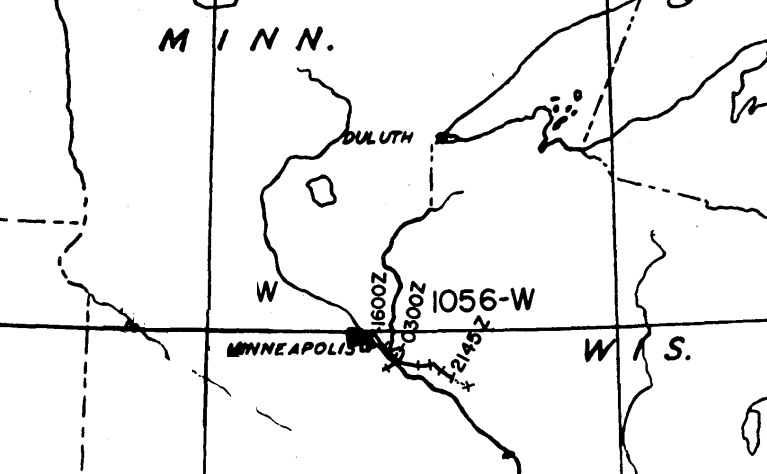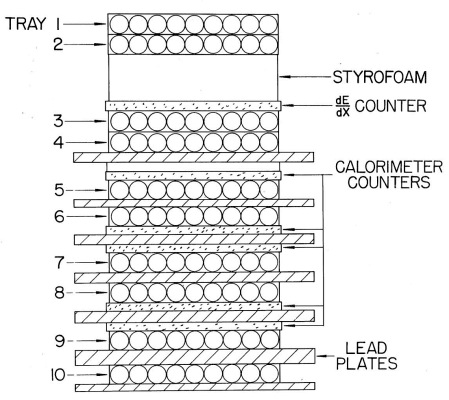Purpose of the flight and payload description
The objective of the flight was to obtain measurements of proton and helium low-energy spectra (100-260 Mev) present in cosmic rays at stratospheric altitudes. The flight was part of a program carried out at high and intermediate latitudes by the Department of Physics and Astronomy of the University of Maryland in a yearly attempt to clarify some of the modulation effects between 1965 -a period of minimum solar activity- through 1969 -a period of maximum solar activity-.
The detector consisted of a Geiger-tube hodoscope, a dE/dx scintillator, and a sandwich of lead and plastic scintillator plates, which formed a total energy calorimeter. The term hodoscope is derived from the Greek roots hodos, meaning path, and scopes, meaning to watch. Thus the term hodoscope is used in particle physics to describe any device (usually electronic) that determines and displays the trajectory of a charged particle.
An schematic diagram of the hodoscope identifying its major components can be seen in the figure at left (click to enlarge). The hodoscope, made up of Geiger tubes, defined the range and geometry of particles incident on the apparatus and detected nuclear interactions occurring in the lead. The tubes were arranged in five pairs of crossed trays to give a 90° stereo picture of each event. The dE/dx scintillator measured the rate of ionization loss of the incident particle.
The light output of the dE/dx scintillator and the combined output of the five calorimeter scintillators were each directed by edge mounted light pipes to a 1 1/2" RCA 6199 Photomultiplier tube. The amplitude of the photomultiplier signal was determined by a logarithmic pulse height analyzer, which had a channel width of 33% (8 channels covered a factor of 10). Two such analyzers were cascaded to cover a factor of 100 in pulse height.
The trays of 1.58-cm diameter Geiger tubes measured 15 by 15 cm, and the apparatus was 32 cm high. The absorber thickness was equivalent to 75 gm/cm2 of lead. Upon receipt of a trigger command, the state of each of the Geiger tubes and the two scintillator pulse heights were read out and recorded as an event. Each Geiger tube and each pulse height discriminator were connected to an associated binary circuit which were connected as a circular 144 bit shift register, then telemetered to a ground station and tape recorded for post-flight analysis by computer.
Details of the balloon flight

Balloon launched on: 8/27/1966 at 12:00 utc
Launch site: Fleming Field Airport, South St.Paul, Minnesota, US
Balloon launched by: Winzen Research Inc.
Balloon manufacturer/size/composition: Zero Pressure Balloon Winzen 749.000 cuft (0.5 Mil. Stratofilm)
Flight identification number: 1056W
End of flight (L for landing time, W for last contact, otherwise termination time): 8/27/1966 at 22:25 utc
Balloon flight duration (F: time at float only, otherwise total flight time in d:days / h:hours or m:minutes - ): 10 h 30 m
Landing site: 1 Mile E of Modena, Winsconsin, US
Payload weight: 215 lbs.
External references
- Balloon Flight Record Facilities for Atmospheric Research Nº 3 - Spring 1967
- Balloon measurements of cosmic ray protons and helium over half a solar cycle 1965-1969 Journal of Geophysical Research, Volume 76, Issue 31, p. 7445
- Cosmic ray proton and helium measurements over half a solar cycle 1965-1969 Thesis by Thomas A. Rygg, University of Maryland, 1971
- Cosmic Rays over the Upper Mid-West Ph.D. Thesis by Thomas A Rygg, University of Maryland, 1972
- Report on Skyhook 1966 Final report for ONR - Winzen Research Inc.
- Solar and geomagnetic modulation of low-energy secondary cosmic ray electrons J. Geophys. Res., 78(10), 1502-1514
5438If you consider this website interesting or useful, you can help me to keep it up and running with a small donation to cover the operational costs. Just the equivalent of the price of a cup of coffee helps a lot.


